How to Successfully Work with Conservation Commissions and Architectural Review Committees
-
 The finished pool with surrounding landscaping. The pool has a cantilevered edge and an aggregate deck.
The finished pool with surrounding landscaping. The pool has a cantilevered edge and an aggregate deck.
-
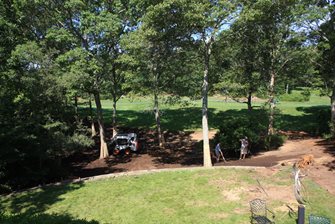 A before picture of the site. In the foreground is where the Abrams pool was soon to go.
A before picture of the site. In the foreground is where the Abrams pool was soon to go.
-
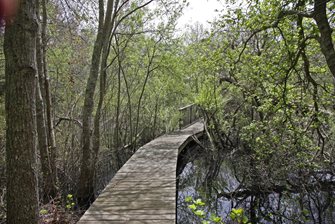 Marsh area protected by the Mashpee Conservation Commission.
Marsh area protected by the Mashpee Conservation Commission.
-
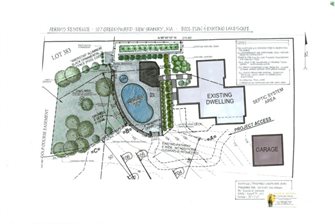 This was the plan approved by the architectural commission.
This was the plan approved by the architectural commission.
-
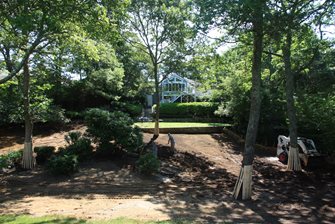 Strips of wood strapped together were required to be placed to protect the trees.
Strips of wood strapped together were required to be placed to protect the trees.
-
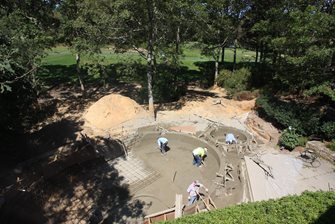 The pool gunite was pumped from the Abrams’ driveway.
The pool gunite was pumped from the Abrams’ driveway.
-
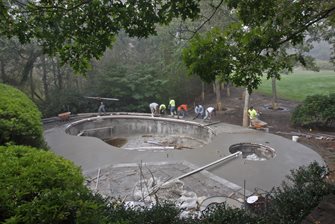 Concrete crew pouring the aggregate deck.
Concrete crew pouring the aggregate deck.
- 1
- 2
- 3
- 4
- 5
- 6
- 7
Cape Cod Massachusetts’ fourteen towns encompass some of the most pristine real estate on earth. Each of the towns has a Conservation Commission charged with keeping their diverse conservation areas pristine. Town Conservation Commissions are often stricter than state conservation guidelines and are never less stringent.
The pool and landscape Elaine Johnson of Elaine M. Johnson Landscape Design designed for Dan and Leonora Abrams in Mashpee's New Seabury residential golf course community is magnificent as you can see. The pool engineering and pool construction, which included pumping the pool gunite over long distances from the driveway, could make for their own stories. But what struck me as the big takeaway from this project is Elaine’s tips on how to work with a Conservation Commission and Architectural Committee.
Miracles Do HappenI wanted to know specifically how Elaine could have met the Abrams in May 2011, got approval from the Mashpee Conservation Commission in July 2011, then got approval from the New Seabury Architectural Committee in August 2011, and then immediately started construction of the project. It can take that long just to get plans done in many cases.
Elaine’s Tips for Working with Commissions & Committees
- Explain to the client that getting approval is a process to be worked through, and that other planning can go on during the approval process. “In this case the Abrams understood what was involved and it was not a problem. If you have a chest thumping client with a position that it is their land and they can do what they want with it, it’s important to talk them down from that perch,” she says.
- Make a personal visit to the conservation commission office; introduce yourself and explain the project showing a rough sketch (no complete drawings at this time). By taking the time to introduce yourself they will understand that you are professional and you want to cooperate with the rules—you’re not some fly-by-night person. Request they make a visit to the site for a meeting.
- At the site meeting, hear all of their concerns. Listen to what is really important to them. Write down every single thing discussed at the meeting. Type it up and send them a copy along with evidence that you understand what you can and cannot do. You may need to refer to these notes later.
- File a notice of intent based on the conversations and the site visit. Go to the Conservation Commission hearing. They will issue an order of conditions for you to follow. Follow those conditions! The agency inspects during construction and after construction will issue a certificate of compliance.
With approval from the Conservation Commission in hand, Elaine submitted plans to the New Seabury Architectural Committee. Again, she visited with them ahead of time and learned the ropes so there was not a big mystery as to what they wanted. Elaine says, “They only meet once a month, so it’s important to get it right the first time.” Approval was granted in August to start construction.
Key takeaways for me were: getting face-to-face, listening, getting agreement of what will work and what will not work, following up in writing, and then playing by the rules everybody agreed to. As Elaine notes, “You will be amazed at what you do as long as you play ball. I have to work with these parties on future projects so I have to play ball.”
If you are an owner looking to hire and your project requires approvals as outlined above, it seems you might interview landscape professionals on not only their design skills, but also their listening, psychological, and diplomatic skills. Things will go a lot quicker.
|
About Elaine Johnson:As the iconic Patti Page song goes; "If you're fond of sand dunes and salty air, quaint little villages here and there, you're sure to fall in love with ole Cape Cod." Johnson's deep appreciation for the architectural styles of the region, from Cape Cod to Colonial, Shingle-style to Saltbox, gives her a unique perspective in designing for these homes. Her style leans towards a more formal aesthetic which complements the architecture and needs little maintenance to do well, yet her landscapes seem to fit effortlessly into their surroundings, much as the homes themselves do. |
|
Contributing Author: Jim Peterson, president of Landscaping Network |




 How to Landscape
How to Landscape Common Landscaping Problems
Common Landscaping Problems Passing Design Review
Passing Design Review

